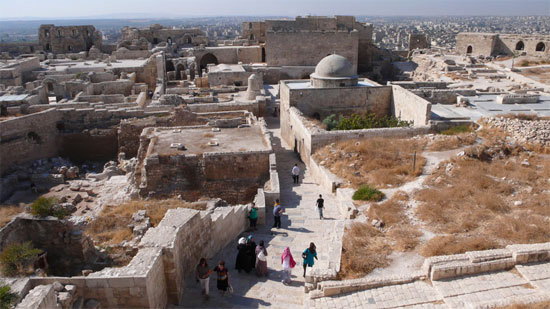Ancient civilization in Syria
Syria was the cradle of civilization 10,000 years ago, with thousands of cuneiform texts and many unearthed old stone fossils, providing an unprecedented view of the daily life of Mesopotamian people. Ancient Ha.
Syria is located in the southwest of Asia, in the Middle East, with a population of about 23 million people. The people here mainly live near the Euphrates River and most of them are Sunni Muslims, accounting for 74%, Alawite Muslims 12%.
Despite being a minority, Alawite Muslims dominate politics for decades, President Bashar al-Assad is among them. About 10% of Syria's population is Christian, a small part of other sects is extremely mysterious with the characteristics of monotheistic religion. While most people in Syria speak Arabic, about 9% of the northeastern population speaks Kurdish.

Medieval palace in Aleppo.(Photo: Shutterstock)
Syria was the cradle of civilization 10,000 years ago, the home of the thriving ancient city of Ebla from 1800-1650 BC.
20,000 texts of cuneiform and many old stone fossils excavated here provide an unprecedented view of the daily life of Mesopotamia at that time. Syria was once part of the major empires in history, the Egyptians, Assyrians, Chaldeans, Persians, Macedonia and Romans replaced each other to rule the region.
The two major cities of Syria are Aleppo in the northwest and Damascus in the southwest, which are two really ancient cities. Damascus is mentioned in an Egyptian document dating back to 1,500 BC discovered at the archaeological site of Tell Ramad, just outside Damascus. And the city of Aleppo may be one of the oldest continuously occupied cities in the world, where people reside from 6,000 BC, the city is located along the Silk Road, so the trade plays developed for centuries.
"Since ancient times, people here know how to build mud brick settlements on the ruins of previous cities, thousands of archaeological sites scattered throughout the country are mostly unearthed." , Jesse Casana, an archaeologist at the University of Arkansas, USA, told NBC News.
Syria has a number of famous Roman cities like Apamea, Palmyra and the beautiful Crusader castle. Damascus is the capital of Syria with many ancient relics and heritage that still exist today such as the temple of Jupiter, the wall of ancient Rome city, an eighth-century Umayyad mosque.

Cuneiform text.(Photo: Public Domain)
For four centuries Syria was part of the Ottoman Empire, Syria was under French control after the Ottoman Empire collapsed in 1918 and became an independent nation in 1946.
Currently, hundreds of archaeological sites are threatened by the civil war in Syria, bombings and looting have destroyed some valuable places. Scientists try hard to preserve the heritage here, they negotiate with the government and rebel leaders to protect the most important treasures, they also compile a list of archaeological sites. 'Do not attack' should be protected.
- Interesting facts about Syria
- The inventions that the Mesopotamian civilization left behind
- Civilizations of aliens?
- Ancient civilizations were forgotten
- Mysterious ancient civilizations unknown
- Unravel the mysteries of the ancient city of Palmyra
- The mystery of the first ancient civilization
- Ever had a civilization in Antarctica?
- Discovered ancient civilization never known in India
- Discovered 4,000 year old fortress in Syria
- Beautiful places, but visitors should not be sharp
- Redefining the age of Indian civilization
 Discovered an ancient centipede fossil 99 million years old
Discovered an ancient centipede fossil 99 million years old Discovered bat-like dinosaurs in China
Discovered bat-like dinosaurs in China Discovered a 200-year-old bronze cannon of the coast
Discovered a 200-year-old bronze cannon of the coast Discover 305 million-year-old spider fossils
Discover 305 million-year-old spider fossils